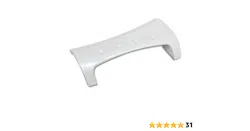Loading ...
Loading ...
Loading ...

ConnecttheInletHoses
Connect the inlet hoses to the wator faucets
Make sure the washer drum isempty.
1. Using pliers, check the tightness ofthe hose couplings
already attached to the washer.
NOTE: Do not overtightan. Damage to the coupling can
result.
2. Attach the hose with the red color indicator to the hot water
faucet. Screw on coupling by hand until it is seated on the
washer.
3. Attach the hose with the blue color indicator to the cold water
faucet. Screw on coupling by hand until it is seated on the
washer.
4. Using pliers, tighten the couplings with an additional
two-thirds turn.
NOTE: Do not overtightan. Damage to the coupling can
result.
5. Turn on the water faucets and check for leaks.
NOTE: Replace inlet hoses after 5 years of use to reduce the
risk of hose failure. Record hose installation or replacement
dates on the hoses for future reference.
Periodically inspect and replace hoses if bulges, kinks, cuts,
wear, or leaks are found.
RoutetheDrainHose
Proper routing of the drain hose protects your floors from
damage due to water leakage. Carefully reed and follow these
instructions.
The drain hose isconnected to your washer.
To prevent drain water from going back into the washer:
• Do not straighten the drain hose, and do not force excess
drain hose into standpipe. Hose should be secure, but loose
enough to provide a gap for air.
• Do not lay excess hose on the bottom ofthe laundry tub.
Floor drain
You may need additional parts. (See Floor Drain under "Alternate
Parts.")
SecuretheDrainHose
1. Drape the power cord over the washer top.
2. Secure the drain hase to the laundrytub leg or standpipe with
the beaded strap provided. (See illustrations 1 and 2.)
2
Ifthe washer faucets and the drain standpipe are recessed
(see illustration 3), put the hooked end ofthe drain hose inthe
standpipe. Tightly wrap the beaded strap around the water
inlet hoses and the drain hose.
Do not force excess drain hose into the standpipe.
LeveltheWasher
Propedy leveling your washer prevents excessive noise and
vibration.
1. Check the levelneas of the washer by piecing a level on the
top edge of the washer, first side to side, then front to back.
2,
3,
4.
Ifthe washer isagainst a wall, move the washer out slightly
before tipping back. Ifthe washer is not level, first prop the
front with a wood block (2" x 4") and adjust the feet as
necessary; then prop the back and adjust feet as necessary.
Repeat this step untilwasher is level.
After the washer is level, use a 17 mm open-and wrench to
turn the nuts on the feet tightly against the washer cabinet.
All 4 fast must be tightaned. If the nuts are not tight against
the washer cabinet, the washer may vibrate.
Slide the washer to its final location.
Confirm the levelness of the washen
CompleteInstaUation
1. Check the electrical requirements. Be sure that you have the
correct electrical supply and the recommended grounding
method. (See "Electrical Requirements.")
2. Check to be sure all parts are now installed. If there is an
extra part, go back through the steps to see which step was
skipped.
3. Check to be sure you have all of your tools.
4. Dispose/recycle all packaging materials.
8
Loading ...
Loading ...
Loading ...
